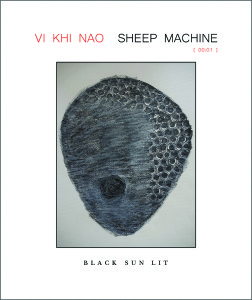Sheep Machine
Vi Khi Nao
Black Sun Lit, 2018
Reviewed by Michelle Macfarlane
The more one gazes and gazes, the more the surface of terror manufactures alienness and abnormality. We think sheep banqueting
on grass is banal and quotidian, but if one is careful to compose one’s gaze, and reflect,
one grows appalling insights into the hackneyed bed of mundanity.
Is it the eye that sees? Or the mind?
In Sheep Machine, Vi Khi Nao’s painstaking process of viewing video footage invites the reader to participate in a mental image-making born of boredom. It is a process wherein she combines the rigor of an unrelenting gaze with a mind relaxed and playful enough to register alarming juxtapositions, to entertain the surreal. Nao’s text invites the reader to dwell in momentary states of terrifying ambiguity; to hone a capacity to wait long enough to see what will emerge from the obscurity of shadow in light’s decline; to wonder what tricks our eyes, our minds are always playing unbeknownst to us.
Nao’s process invites the reader to participate in the surprise of seeing.
01:52
When the observer stops time, miracles happen.
For example,
01:57
The smooth surface of the sheep’s back. So smooth and glossy, it could easily be a mirror for the sky.
An ekphrasis set in the twilight space of Leslie Thornton’s 2011 video of sheep feeding beneath an aerial tram that ascends and descends a mountain in the Swiss Alps, Nao’s Sheep Machine is a second-by-second textual record of her perceptual experience of the video’s unwinding.
00:27
This is just the beginning of different surfaces of existence exchanging ontological blows with one another.
Two spheres not wanting to be the same remain not the same.
Gradually, the reader comes to “see” that the video’s paired images and Nao’s text remind us how binoculars function as extensions of our eyes, how, though paired, each human eye registers the world from its unique vantage point, how the brain measures slight differences between the two vantage points and registers these as stereoscopic depth, “a single, solid vision.” Thornton’s video insists on the presentation of two views of the same scene so radically different, however, that they cannot be reconciled within the brain’s visual apparatus.
00:25
A shift, a slight movement, can engineer another dimension and suggest another reality.
Where Thornton’s left lens presents what one might expect to see through the left lens of a binocular—
01:01
This is a tower with steel cables…. This is wheat and grass
her right lens presents what one might see through a kaleidoscope, wherein
00:04
mountains can become medium-sized primates and generally mischievous.
Nao’s text attempts to simultaneously negotiate two irreconcilable images.
01:17
From Right Lens, you can discern the five legs of the mechanical star begin to shift the color of their pantyhose. The mechanical star has a slight tan color,
the same color of the coffin floating midstream in Left Lens.
00:42
Binocularity reshapes the way we split ourselves into geometrical pieces.
What Nao sees in the left binocular lens of Thornton’s video are the objects to be reflected. They lie within in a chamber at the far end, and they tumble, so to speak, when the cell is rotated. The smallest shifts in wind, light, shadow, or movement within the left lens will cause the corresponding shifts in color, shape, and position on the right.
01:52
So much takes place in one threshold of time.
“…pending, arcing, bending, bowing, eating, falling, standing, flickering, piercing, leveling, shifting…”
02:52
Life is made ordinary and extraordinary by these common events taken out of context, frame by frame.
Thus, Nao’s perceptions transform—and deform—so that sheep, wool, grass, wheat, aerial tram, cables, tower, clouds, sky, light, and shadow become monkey Yodas, blades, needles, slivers, erection, penis, elephant trunk, birth-mark, loaf of bread, ceremony, god’s will, arrowheads, torpedoes, Machu Picchu, Abraham’s sacrifice, sheep porn, crack in the earth, coffin, Japanese men in wool business suits, coffin-carrier, cosmic Lego, wool Buddhas, wool volcanoes, corpse carriages, carpet, textiled sun-dial, wooly walrus, white carpet bison, huge dog, hat the color of straw, spool-wound film, waffle maker, mattress, alien, clusters of fabric, elongated nipples, folds of vaginal walls, lighthouse in Michigan, bucolic monster, Siamese twins, Emily Dickinson’s coffin, Darth Vader’s mask, five stained-glass spears, light switches. Literal observations become metaphors.
Between the near and far ends of a kaleidoscopic vision, Nao’s text situates the reader in a darkened chamber of mirrored images creating an infinity of patterns as light reflects throughout.
01:56
Three sheep bend while one conceals itself behind the behind of one of the two.
01:57
Now the neck of the fourth sheep has shifted closer to the others, its furry, wooly head, almost raccoon-like. Almost. Almost.
Literally moving from one moment to the next in a near stasis of time, Nao’s text gives the viewer, the writer, the reader, the time to experience—to extrapolate—what are normally quickly shifting scenes before the eyes, and in the mind.
00:09
As the seconds unfold in Thornton’s world, ominous perceptions emerge to invite possibility and space for apocalypse.
00:27
The main star defines their minor radiance (monkey Yodas) through white dashes as it traces the pentagon.
Nao’s text takes the time to process what is seen, the time to apprehend the tricks that light can play, the tricks the eye can play, the tricks that our minds and language play. Her text takes the time to ask,
00:35
What is it like to endure bifurcation? And to stand still in the midst of separation? One eye split at the center for the pleasure and endurance of another eye?
It takes the time to begin to apprehend the irreconcilable, to consider the violence of the irreconcilable.
00:33
Everything about the Sheep Machine invites terror.


